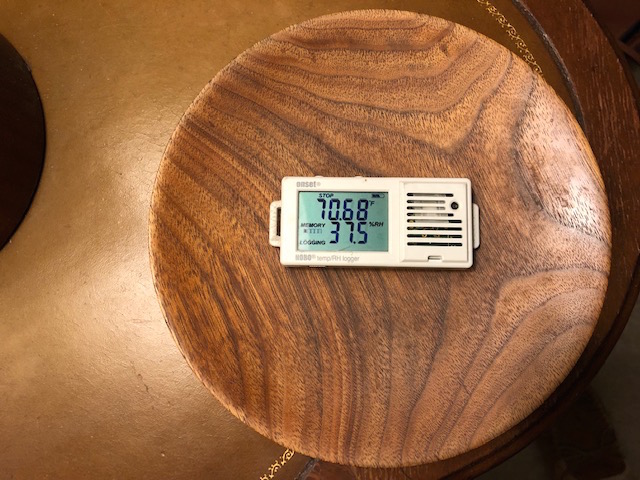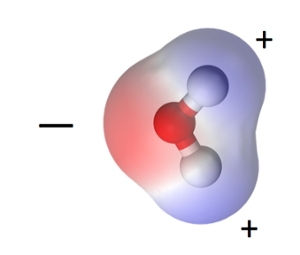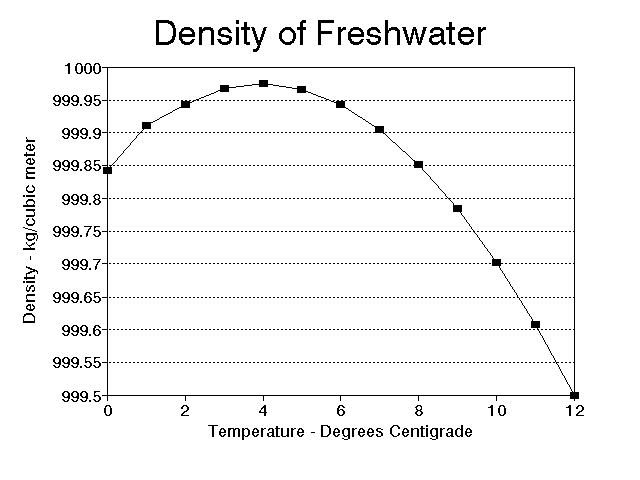Controlling the Humidity in Your Home in Winter

I’m going to go out on a limb and make what you may think is an outrageous statement: Water is the most interesting substance in the world. Some of you may immediately respond, “Oh, yeah! What about beer?” (Or wine or Sidecars, Negronis, or Sazeracs or whatever your drink of choice is.) Without water, we wouldn’t have those drinks.
But what else makes water so interesting? Well, let me name a few. The water molecule is polar, which makes for lots of interesting properties.

When liquid water becomes a solid, it does the opposite of most other materials making that phase change: It becomes larger! And did you know that liquid water reaches its highest density at 4 °C (39 °F), not 0 °C (32 °F)? That’s right. It starts expanding even before it freezes.

That fascinating property ensures that fish don’t freeze into a block of ice in winter because as the air above chills the water in a lake or pond, the water becomes more dense and sinks…until it reaches 4 °C. As the temperature goes below 4 °C, the water becomes less dense and sits on top of the more dense water. And that’s why lakes freeze from the top down instead of the bottom up, sparing all the fish in the process.
But you’re here to find out about water in its vapor form so let’s get to that now.
Reasons your home’s indoor humidity is too low in winter
Another amazing property of water is that it can change among all three phases at the temperatures and pressures we spend our lives in. Oxygen doesn’t do that. Carbon dioxide doesn’t do that. Ethanol doesn’t do that. But water regularly passes from liquid to vapor and vapor to liquid in your home. It makes humidity control tricky, of course, but it also makes our lives more interesting.
Anyway, if the relative humidity in your home is too low in winter, the overriding reason that happens is:
You’re bringing in too much outdoor air!
But how does that happen? The first thing to know is that cold air is dry air. Water loves to change phase and when the temperature drops, those little water molecules love to cling to other things and to each other, becoming liquid or solid (or adsorbed, a kind of fourth state).
- Infiltration. Your house is too leaky. Seal the leaks.
- Duct leakage. This one’s similar to the other except your furnace or other type of forced-air heating system is either directly bringing in outdoor air through leakage on the return side or indirectly bringing it in through changing the pressure in the house.
- Mechanical ventilation. With building codes requiring airtightness these days, many homes now have whole-house mechanical ventilation systems. If you bring in a lot of outdoor air and don’t run it through a device like an energy recovery ventilator (ERV) that preserves some of your indoor humidity, you can end up drying out the house.
- You were raised in a barn. At least that’s how my parents put it to me when I left doors open.
Solving the low humidity problem
The solutions to low humidity are pretty obvious. Cold air is dry air so limit the amount of cold air you bring in and you won’t dry out the indoor air so much. But what do you do during the Polar Vortex? Or if you live an place where it’s super cold every year?
Well, you could cook a lot of spaghetti and take a lot of steam baths or put in a humidifier to raise the humidity level in your home. You also can not turn on the bath fan when you take a shower. You need to be careful with those things, though, because remember, those water vapor molecules will look for ways to get out of the vapor phase when it’s cold. If you have cold enough walls or windows or other surfaces and you add too much humidity, you’ll get condensation.
It’s a delicate balance you’re trying to achieve. You want the Goldilocks humidity level: not too low and not too high. You want it just right.
Generally , the colder it is outside and the worse your home’s level of insulation and air-sealing is, the lower the humidity your home can tolerate. You might have to be happy with 30% relative humidity, maybe even a bit lower. If you live in a Passive House, however, you can probably keep the humidity up near 50% and not even see condensation on your triple-pane, high-performance windows.

Another option is to get outside and enjoy water in its frozen form!
Related Articles
What Is the Best Indoor Relative Humidity in Winter?
Two Rules for Preventing Humidity Damage
A Humidifier Is a Bandaid — The Problem Is Infiltration
NOTE: Comments are moderated. Your comment will not appear below until approved.
This Post Has 30 Comments
Comments are closed.

Thanks Allison, I knew it was
Thanks Allison, I knew it was polarized but I did not realize the nuances of the water molecule – very cool! (but not so cool in a humid environment that it promotes condensation!). Also another relevant point – the fact that water is a polarized molecule is the primary reason that insulation looses insulation efficiency when it becomes damp. This is another reason why we never recommend open cell insulation on the underside of a roof (and vapor barriers on open cell sprayed in place foam is a challenge to get right worse than housewrap on a windy day).
We were told to put open cell
We were told to put open cell foam on our roof deck in our main attic, as it was not venting well and causing ice daming. We now have an off gassing issue (sweet chemical smell, or burnt coffee type of smell) with the foam when it is humid outside or too humid inside. We have also just discovered that the few spots we have cut out show it is not adhering to the deck and has a 1 inch gap where you can feel cold air moving behind the foam. We also found out that the installer did not make the entire attic monolithic, only about 50% of the attic where we had no floor boards did he make the foam come down far enough, so we have air infiltration there. He also told us to leave the old blown in insulation that was under the floor boards in the attic to leave in place. We do have a hard time getting the humidity under control in the house. We have a 100 year old home that has also been added on to. We have the foam in many of the walls too, in the crawl space(where it is also off gassing) and in 2 other attics in the house. We have an ERV, dehumidifier, humidifier, 2 ac units, 2 furnaces which are forced hot air. One set is in the attic, one set is in the finished basement. The humidity in the house can quickly go from bieng too dry when humidifier set low with the wood cracking to the windows dripping with water when set a little higher. Trying to decide if we need to rip out the open cell foam and start over or if we should try to fix the problems with the foam. It is a large house and attic, so none of this is cheap to do. Any and all adivce would be appreciated. Installer and manufacturer are being horrible about the problem and not wanting to help. We just want to solve the problem.
Allison: Thank you, I will
Allison: Thank you, I will sleep better tonight as I finally understand that the fish are safe. And I can verify that humidity levels stay reasonable in a Passive House. I’m in climate zone 6. Nighttime lows dipped below minus-10 F on a few nights; relative humidity changes very slowly to a low of 36% at 65 F. That is with an ERV running, and I take no steps to raise the humidity.
If your outdoor temperature
If your outdoor temperature dropped below -10F then you are in zone 5 according to USDA. Even for one night. Here in Vermont we were heading to a year (2019)in zone 7 , but a couple sub zero’s (single digits) have put us in zone 6. Of course the maps most garden catalogs use are never updated, so they mostly have us in zone 4
No need to search online,
No need to search online, Brian. I wrote about the International Energy Conservaton Code (IECC) climate zones here:
Do You Know Your Building Science Climate Zone?
Thanks Allison, but I’m also
Thanks Allison, but I’m also familiar with the building version of climate zones. What made me believe that Daniel was addressing the agricultural system was his reference to the actual temperature in his area. As far as I’ve seen there’s no specific temperatures embodied in the building climate system, only broad areas most likely tied to heating degree days, average annual precipitation, etc.
Brian, yeah, I see how that
Brian, yeah, I see how that could happen, especially since there’s some overlap in the USDA and IECC climate zone numbers there. There would be no confusion in a place like Florida, though, where the IECC climate zones are 1 and 2 and the USDA zones range from 8 to 11.
@Daniel, around these parts,
@Daniel, around these parts, any reference to climate zones means IECC Climate Zones (google it), which are ‘backwards’ from USDA climate zones… Z1 includes the southern tip of Florida, Z7 includes northern Minnesota.
Sorry, my previous reply was
Sorry, my previous reply was intended for Brian, not Daniel 🙂
I’ve got a question on this
I’ve got a question on this topic. We live in a VERY badly built SIP house that isn’t sealed properly at the joints between the panels and, during the winter, we get significant condensation on many of the windows every night through the winter (Central Ohio). However, every day we can open the blinds and dry the windows off (except if the daily high is below 0F).
Given that this happens with the indoor RH in the 30-40% range, does it represent a significant threat to the house that justifies trying to get the indoor RH <30% even though that causes health problems for my wife and I?
@Ty, condensation on glass
@Ty, condensation on glass has nothing to do with SIPS or leaky SIPS joints. It’s all about indoor RH and the surface temperature of the glass. In fact, if your home were tighter, presumably the indoor RH would be higher, which would only exacerbate the condensation problem.
Sounds like the efficiency (u-value) of your glass is not on par with your SIPS envelope. I’ll hazard a guess that you don’t have triple pane windows? In fact, it sounds like you don’t have particularly good double pane glazing, although there are several other factors at play here that could explain your problem:
First, unless you have an expensive hydrometer, it wouldn’t surprise me if your RH measurements are off (on the low side) by 5% or more, typical of consumer grade RH meters. Even ‘good’ double-pane windows will condense in your climate as indoor RH approaches 40% (I’m guessing that happens when outside temps drop into the single digits, depending on u-value and frame design). Second, isolating the glass from the heat source by covering window with curtains or blinds lowers the surface temperature and thus increases the likelihood of condensation. And third, setting back the thermostat at night likewise increases the likelihood of condensation.
As for whether condensation poses a threat to the house depends on whether your windows have wood frames and whether water runs down onto other wood surfaces or worse, into the wall cavity below the window.
The solution is to reduce RH (by increasing ventilation) and/or raising the temperature of the glass (by minimizing isolation due to window coverings, and/or raising indoor temperature).
One of my Chemistry
One of my Chemistry professors said he’d like to teach a whole class just on water. How water defies just about all normal “rules” in the chemical world.
Another interesting fact, Water ice is the only solid that can reconnect itself when cut.
Born in a barn? My parents
Born in a barn? My parents said that I was born in the basement and never brought up!
I have heard people claim that gas furnaces dry out houses in the winter time which is why hydronic heat is better. These people even refer to hydronic heat as “wet heat”. Have any of you heard this? Do you believe it? The only rationale that I can see behind furnaces “drying” the air is if it is due to leaky ducts causing more air exchange with the outdoors, as Allison described above.
Aside from duct leakage
Aside from duct leakage combustion air may also be a factor if the furnace is inside the building envelope. The “dry air” complaint is also levelled at wood stoves and they don’t have ducts.
Hi Roy, I’ve heard that
Hi Roy, I’ve heard that expression many times over the years, particularly from wet-heads (someone who advocates hydronic heat, especially the radiant variety. I guess that makes me an ‘air-head’ =:o
Methinks the misconception that furnaces dry the air is simply because people associate winter indoor dryness with their heating system the same way they associate drying their hair with a hair dryer.
The fact is, furnaces do nothing to raise or lower indoor moisture levels, at least not in absolute terms. OTOH, by warming the air, furnaces do lower relative humidity, but that’s only a function the thermostat setting, not the type of heat. A hydronic system (or a heat pump, or any other type of heat) set to the same temperature would have an identical impact on indoor RH as a furnace.
Having said all of that, as Allison points out, leaky return ducts (located in unconditioned space) will draw in more outside air, thus lowering indoor humidity in cold weather. This argument might be used to put a better shine on radiant heat, which has no ducts to leak. But as I would tell my wet-head brethren, the solution to that is tight ducts. Or better yet, to not route them through unconditioned space!
Ducted hot air furnances do
Ducted hot air furnances do in fact dry out the air, but it does it by driving infiltration rates, not by heat. To move air in ducts requires creating pressure differentials- no duct system is perfectly balanced (though some are much worse than others), and no house is perfectly air tight (though some are much MUCH worse than others). The induced pressure differences by the duct imbalances makes SOME of the air return via “the Great Outdoors”, and with it is exchanging drier outdoor air with more humid indoor air. This effect is typically orders of magnitude higher than mere combustion air issues.
This does not happen with hydronic heating.
An Energy Star duct system requires that duct be balanced well enough that room-to-room pressure differentials never exceed 3 pascals (0.012″ water column) under all air handler speeds, all operating conditions, room doors open or closed. That is not an impossibly difficult hurdle to clear, but most existing duct systems aren’t anywhere near that mark. The tighter the house, the less that matters, but most existing homes aren’t even compliant with the IRC’s 3 air exchanges at 50 pascals max either (which is also not a high hurdle to clear for new construction, sometimes tough to retrofit seal in a plank sheathed antique house.)
Even an Energy Star duct system in an IRC compliant house still has some amount of air-handler induced drying, but it’s an order of magnitude lower than a typical house & duct system. But even a leaky house will hot experience heating system driven infiltration/drying with hyrdonic baseboard or radiators (but will with ducted hydro-air.)
Furnace heat we call SCORCH
Furnace heat we call SCORCH AIR
It’s raining outside, the
It’s raining outside, the heat is not on and my humidity is 43% – Boom.
Any recommendations on a good
Any recommendations on a good inexpensive hygrometer that shows the dew point?
@Norman, I’m not aware of any
@Norman, I’m not aware of any consumer product that displays dew point. As it turns out, dew point is difficult (i.e. expensive) to measure directly. I have an infrared hygrometer that measures dew point directly (Vaporstat 9002), but it costs north of $400.
Dew point can be calculated from relative humidity and temperature (although the formula is non-trivial). Now that many thermostats include RH measurement, I’m disappointed that none display dew point. It would cost next to nothing to add this feature!
If you live near an official NWS station and at a similar elevation, the reported dew point can be a reasonable proxy since absolute humidity is typically uniform across a fairly wide geographical area (more so than temperature). If you want to know the indoor dew point and you know the temperature and RH, you can look up the corresponding dew point at http://dpcalc.org.
Do any of you ever use a good
Do any of you ever use a good old fashion sling (dry/wet bulb) psychrometer? Or better yet, an aspirated dry/wet bulb psychrometer? That is still the standard in many test labs.
I’ve never used an aspirated
I’ve never used an aspirated psychrometer but many years ago, I fashioned my own a sling psychrometer with a couple of glass mercury bulb thermometers. More recently, I worked in R&D at a diagnostic tools manufacturer. We calibrate our production humidity sensors in a Thunder Scientific chamber. I believe it measured vapor content directly via infrared. I wonder how many HVAC techs even bother to measure wet bulb temperature these days, or use a psychrometric chart?
Hi Allison, love the post as
Hi Allison, love the post as always. Perhaps you could do a study next on why people are relatively unhappy with forced air heat versus radiant heat. I always assumed it was due to humidity levels (assuming that forced air is dried out). However I am living in a a super insulated and well sealed house with a good ERV. We have forced air for the first time (ductless mini splits)and our Indoor Humidity in the Winter is always around 45%. We keep the temp at around 64-64 deg. Yet I can’t breathe. Neither can my son. (Hubby fine- but you know- he has no feelings ;). We are ok in the summer- horrible in the winter. Never had this problem with our Radiant heat. Why???
@Elizabeth, I would posit
@Elizabeth, I would posit that your symptoms are unrelated to the type of heat you have.
What do you mean when you say
What do you mean when you say “Yet I can’t breathe”?
My suspicion would be a mold
My suspicion would be a mold issue. I would look into that.
When I say I can’t breathe I
When I say I can’t breathe I mean that my nasal passages get so dried out and inflamed that it is hard to get enough air through. So I start mouth breathing (way TMI!) and wake up feeling sluggish and with a mild headache. I know that I have a deviated septum – as does my son- so I know the physical reasons this happens to us but the reason I am posting here is that we have lived in this house for a very long time. Until 3 years ago it was a leaky house with radiant heat. Winter or summer- no real difference with breathing. Now that we are super insulated, triple pane windows, and have 2 ductless mini-splits + ERV, our breathing in the winter is bad. Whereas, it is totally fine 3 out of 4 seasons. This is our third winter- each the same.
As was mentioned in a couple of other posts here, many people seem to have breathing issues with forced air versus radiant systems. I have always told my clients (I am an architect who specializes in Net Zero and PH in the North East) that it will not be an issue if you insulate well and build right. I also always mentioned that if you have a ductless mini split you won’t have any problem for sure. Now I don’t say that anymore.
I really have no idea why this is happening. I am open to the idea that it is not the heated air but other than that nothing else is really different in winter in our house. Same people and pets, same cleaning schedule, same bed linens. We even open the windows once in awhile in the winter as we do in the summer. The Humidity in winter is almost always 45%, and in the summer it gets up to about 55%. Both of which seem pretty perfect. Temp is almost always 64 to 66 degrees F no matter what the season.
SO, I want Allison to do all of the work researching this issue, lol. Its been on my own to-do list for a couple of years now- why not have him do it? 🙂
If your indoor relative
If your indoor relative humidity in the winter is 45%, you are doing pretty good compared to most houses. So I am surprised that you are having problems with dry nasal passages. What was your winter indoor relative humidity before you did these changes to your house?
Great article. Here in
Great article. Here in Florida, we never really see super low temperatures outside, but we always deal with humidity in the air. The same still applies, don’t let in the outside air, or a common Florida statement, “Stop air conditioning the neighborhood.” (In other words, close the door!!
Hi everyone,
Hi everyone,
I live in Boston in the east coast and I have had this sore throat for 4 months now. My doctors said it could be allergies. I live in the basement (finished) and the floor is carpet. Do you guys think I should get a humidifier or dehumidifier fire for my bedroom (basement) since winter is approaching? Thank you so much in advance.